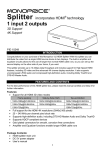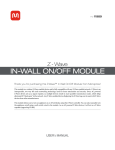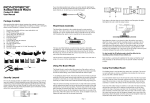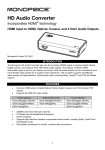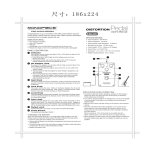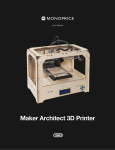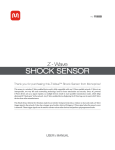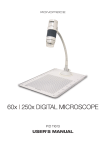Download 1 input 4 outputs
Transcript
Splitter incorporates HDMI® technology 1 input 4 outputs 3D Support 4K Support PID 10250 INTRODUCTION Congratulations on your purchase of this Monoprice 1x4 HDMI Splitter! With this splitter, you can distribute the video from a single HDMI source device to up to four displays. The built-in amplifier and equalizer circuitry allows for the use of longer than normal HDMI cable runs, so you can set up the second display on the other side of your home, if you want. This splitter provides up to 10.2Gbps data throughput and includes support for High Speed HDMI features, including 3D video and the advanced 4K cinema display resolution. It also supports uncompressed LPCM audio and compressed high-definition audio, including Dolby TrueHD™ and DTS-HD Master Audio™. FEATURES AND CONTENTS For the best performance of this HDMI splitter box, please read this manual carefully and keep it for further information. Features: Support for all HDMI 3D video modes Frame packing Side-by-Side (Half) Top-and-Bottom [email protected]/24Hz [email protected]/60Hz [email protected]/24Hz [email protected]/60Hz 1920x1080i@50Hz [email protected]/60Hz 1280x720p@50Hz 1280x720p@50Hz Full support for the HDMI 4K resolutions (3840x2160 pixels) 25 ~ 340 MHz per channel pixel clock rate Supports high-definition audio, including DTS-HD Master Audio and Dolby TrueHD Supports HDCP compliant devices Gold plated connectors for smooth, corrosion free connections Amplifier and Equalizer functions enable longer HDMI cable runs Supports two display type detection techniques Reset button on front panel for quick system resets 1 Package Contents: HDMI splitter main unit DC 5V power adapter User’s manual CONNECTION DIAGRAM The following illustration shows a typical connection using this HDMI splitter, a Blu-ray drive source, and four displays. 3D Blue-ray DVD player Power Adaptor Detection Mode Selection HDTV 4 (3D, 4K×2K) HDTV 3 (3D, 4K×2K) HDTV 2 HDTV 1 (720p/8-bit) (1080p/8-bit) EDID MODE SELECTION When a display or sink device is connected directly to a source device (e.g. Blu-ray player) the source device checks the display's Extended Display Identification Data (EDID) to determine its capabilities, then adjusts the output to match those capabilities. For example, if the display's maximum resolution is 720p, the source device will know not to output video at the 1080p resolution. The Display Type Detection Mode setting determines which of two methods will be used to determine the display type settings to send to the source device. The switch on the back panel of the splitter determines which method to use, A or B. The default setting is detection method A. Detection Method A: Highest Common Factor Mode The first detection method polls the capabilities of each connected display then selects the best quality settings that are in common between all sink devices. Assuming that all displays in the CONNECTION DIAGRAM sample above are powered on, the splitter will tell the source device to limit its output to 720p resolution and 8-bit Deep Color because that is the maximum common capability among the four displays. This detection method is the best one to use if you will have multiple active displays/sinks, each with different capabilities. An example would be a sports bar with several displays of different sizes and capabilities. 2 Detection Method B: Priority Mode The second detection method is much simpler. Starting with the first output port, the splitter polls each port for an active display. It will then send the EDID information from the first display discovered to the source device. In the CONNECTION DIAGRAM sample above, if all four displays are powered on the splitter will tell the source device to output video at 1080p with 8-bit Deep Color. This would result in the second display being blank because it is incapable of displaying video at 1080p resolution. This detection method is best for situations in which you will only have one of the four connected displays/sink devices powered on at the same time. An example would be a home video distribution system where you may choose to watch TV in the living, in the den, on the back porch, or in the bedroom, but not at the same time. Note: If you want to use detection method B and have more than one display powered on at the same time, we recommend that you connect the displays in order, from lowest capabilities to highest. In the CONNECTION DIAGRAM sample above, the first two displays should be swapped so that the lowest capable display would be the first one discovered by the splitter. INSTALLATION For installation you will need a High Speed HDMI cable for each connected display and another for the source. If all outputs are going to be used, you will need a total of five High Speed HDMI cables, which are not included with this splitter. 1. Using a High Speed HDMI cable (not included), plug one end into the output of your Blu-ray player (or other video source device). Plug the other end into the INPUT port on the back of the splitter. 2. Using a High Speed HDMI cable (not included), plug one end into the input on your first display. Plug the other end into the 1 port on the back of the splitter. 3. Using a High Speed HDMI cable (not included), plug one end into the input on your second display. Plug the other end into the 2 port on the back of the splitter. 4. Using a High Speed HDMI cable (not included), plug one end into the input on your third display. Plug the other end into the 3 port on the back of the splitter. 5. Using a High Speed HDMI cable (not included), plug one end into the input on your fourth display. Plug the other end into the 4 port on the back of the splitter. 6. Decide which method of display detection you wish to use in your system. Set the A/B switch on the back of the splitter to A or B, depending on which method you want to use. If in doubt about the best method, use method A (default). 7. Plug the DC connector on the power adapter into the DC 5V input port on the back of the splitter. Plug the power adapter into a nearby power outlet. 8. Power on your source device and the four displays. Content played on the source device should be seen on all the displays. NOTICE Specifications, hardware, software, packaging, and manuals are subject to change without notice. HDMI, the HDMI Logo, and High-Definition Multimedia Interface are trademarks or registered trademarks of HDMI Licensing LLC in the United States and other countries. Dolby is a registered trademark of Dolby Laboratories. DTS is a registered trademark & the DTS logos and Symbol are trademarks of DTS, Inc. 3



